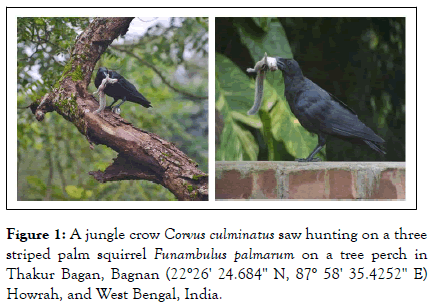Entomology, Ornithology & Herpetology: Current Research
Open Access
ISSN: 2161-0983
ISSN: 2161-0983
Short Communication - (2023)Volume 12, Issue 2
Crows are nature’s most adaptable animals which has survived almost anywhere amidst the growing human population and urbanizing environments. The jungle crow remains to be a species of great interest as it tends to possess unique characteristics being an opportunistic feeder. The feeding habit of Indian jungle crows have been studied in the past and is well known although, there remains unusual feeding habits of this species often documented rarely. Herein, we have documented a rare circumstance of a jungle crow hunting on a live three striped palm squirrel on a treetop. This observation shows the opportunistic feeding habit of jungle crows and the flexible foraging methods.
Feeding behavior; Opportunistic omnivore; Small mammal; Rare documentation
Jungle crows (Corvus culminatus) Sykes, 1832 belong to the family corvidae are large sized crows (body length 40 cm-55 cm) found in Asia's forested regions and in far East Asia. They can be found in a variety of forests, including broad leaved deciduous, broad leaved evergreen, and mixed coniferous. Found in farmlands with hedges as well as wooded areas of city parks, making them one of the most familiar bird species to Japanese people. They display a variety of behaviors related to problem solving and flexible reasoning [1-5].
Feeding habits of any species, which are closely related to behaviour and morphology, are a fundamental ecological parameter of any living organisms. This species' diet most likely reflects the ecosystems of its local habitats, implying that the diet varies by region. Although most crow diets appear to consist of plant material, insects and scavenged carrion, stomach content studies and previous published observations suggest that they can be effective predators of small mammals, other birds, reptiles and amphibians. This diversity in feeding habit is associated with a diversity of foraging methods. It is an omnivorous opportunist and generalist. It may soften its food by dropping it in water, and it has also been observed eating sand after feeding on carcass meat (Figure 1).

Figure 1: A jungle crow Corvus culminatus saw hunting on a three striped palm squirrel Funambulus palmarum on a tree perch in Thakur Bagan, Bagnan (22°26' 24.684'' N, 87° 58' 35.4252'' E) Howrah, and West Bengal, India.
Jungle crows have a diverse set of food preferences. They eat insects, bird eggs, and chicks, as well as dead animals. They also consume various tree fruits and seeds, highlighting their role as a seed disperser. Jungle crows eat food, frequently tearing it into small pieces, and they feed their young in their nests directly from the gular pouch, making video recording difficult to identify the food items. In the evening, they congregate at communal roosts and regurgitate indigestible portions of food as pellets.
At about 9:14 hrs on 20th August 2022, we observed a jungle crow seen hunting a three striped palm squirrel Funambulus palmarum on a tree perch in Thakur Bagan, Bagnan (22°26'24.684'' N, 87°58'35.4252'' E) Howrah, West Bengal, India. This is a first and rare instance of a crow predating on a live small mammal from West Bengal.
The documentation of this feeding habit is sought as evidence to feature the behavior of jungle crows in a sub urban habitat where they are regarded mostly as scavengers. The family corvidae has been documented and studied well in the past, although many unknown interesting, rare records shows a new dimension to the existing studies. Further, studies need to be done to understand the feeding ecology of family corvidae who tend to co-exist with the humans [6,7].
The authors declare no conflict of interest during the preparation of this article.
We are thankful to earth crusaders organization for their social awareness on wildlife from grassroot level and helping in drafting of this manuscript.
Citation: Bera A (2023) Rare Instance of a Jungle Crow Corvus culminatus Sykes, 1832 Hunting on a Live Three Striped Palm Squirrel Funambulus palmarum Thakur Bagan, West Bengal, India. Entomol, Ornithol and Herpetol. 12:294.
Received: 08-Sep-2022, Manuscript No. EOHCR-22-18753; Editor assigned: 12-Sep-2022, Pre QC No. EOHCR-22-18753 (PQ); Reviewed: 26-Sep-2022, QC No. EOHCR-22-18753; Revised: 09-Jan-2023, Manuscript No. EOHCR-22-18753 (R); Published: 16-Jan-2023 , DOI: 10.35248/2161-0983.23.12.294
Copyright: © 2023 Bera A, et al. This is an open-access article distributed under the terms of the Creative Commons Attribution License, which permits unrestricted use, distribution, and reproduction in any medium, provided the original author and source are credited.